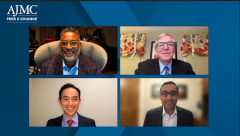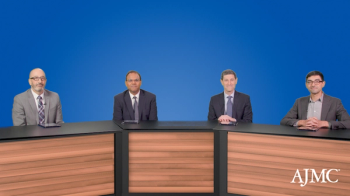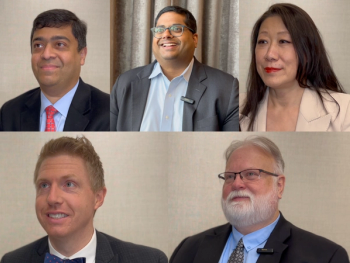
Treatment Barriers Facing Patients With DME and Wet AMD
Caesar Luo, MD, FASRS, FACS discusses the biggest barriers for patients with wet AMD and DME to receiving optimal treatment and his strategies to overcome these barriers.
Jim Kenney, RPh, MBA: Dr Luo, what are the biggest barriers for patients with wet AMD [age-related macular degeneration] or DME [diabetic macular edema] in receiving that optimal treatment?
Caesar Luo, MD, FASRS, FACS: You can look at this several ways. If you look at it from the patient’s side, we’ve covered some of these topics already. Dr Coney hit a lot of them on the head. It’s challenging to come in. Given the choice, they don’t want to come in. It’s easy to always make that decision to find something else to do instead of getting a needle stuck in their eye. Adherence as best practice is difficult. Dr Sheth brought this up earlier. We still don’t have any data better than MARINA and ANCHOR, our first trials, because those patients were getting Lucentis [ranibizumab] every 4 weeks the entire time they were treated. We try to cut back on that, but we still maintain that vision is the goal. Unfortunately, that’s very difficult for our patients to do. The amount of ancillary tests and treatments that especially our patients with diabetes need to undergo is overwhelming.
There’s also a large treatment burden or treatment barrier from our standpoint and the provider’s standpoint. We talked a little about this earlier. It’s frustrating when we can’t make what we think is the most clinically appropriate decision. For the most part, unless the patient has government insurance—and by that I mean just Medicare with a secondary—I have to look at every other patient before I can give them a treatment. I have to know exactly what their insurance tells me I can give them. That’s a huge barrier to treatment. If I’m watching someone actively have more fluid on their scans, but I can’t do anything else differently because the patient has to pay out of pocket for their treatment, that doesn’t sit well with us as clinicians. We’re the treaters. We don’t see the dirty underbelly of this whole operation. Yet when we have to look at it, it’s a problem because there are a lot of barriers to these patients being able to get what would be best for them. Cost is a big issue.
The last thing is looking at it from the patient’s standpoint in terms of cost. Besides missing appointments or choosing other treatments, cost is a big thing. We’ve all had patients that lost their insurance, maybe they lost their job. They say, “You know what? I could not come in for a year.” No matter what I tell them, I say, “I will treat you for free. I don’t care. I don’t want to watch you go blind.” They say they didn’t know that; they didn’t have insurance. Honestly, that’s probably the majority of folks who disappear off our radar. Cost is not just to the health care side or payer side but also to the patients. Sometimes, a $5 or $10 co-pay is too much when they’re on a fixed income. These are important considerations. The more we can support these patients, the better for their vision and long-term care.
Jim Kenney, RPh, MBA: You hit on an important topic: patients who go untreated. Studies on Medicare beneficiaries have shown that 53% to 58% of patients receiving treatment discontinue within the first year. Dr Coney, why are they reluctant to start therapy or discontinue therapy prematurely?
Joseph Coney, MD, FASRS, FACS: Those are 2 separate questions. I’ll take the first: the reluctance to start therapy. This has to do with communication. One thing I’ve learned during COVID-19, and learning more about this journey and patients, is that sometimes it’s not about what we tell patients. We can tell the patients everything correct—the right therapy, what to do, etc—but if they feel we haven’t connected with them, we haven’t done a good service, and then they don’t have faith in us. We have that communication up front to try to set some expectations and let them understand that this is a disease and there’s no cure for it. You may need long-term therapy just to stabilize the disease. It’s important to have that conversation up front so they understand why they need to come in. We have to understand why they have equity.
The most important thing is that our ancillary test has been a powerful tool. I show them: this was your scan when you first came in, and this is your scan now. This is your fluorescein now, this is blood, this was the dead area in your eye, and this is where those things have been improved. That helps them understand why they should keep those appointments. Once they understand the improvement they have and the vision gains they’ve achieved, then you give them positive reinforcement with the ancillary test. It keeps them in the fold to keep those follow-ups.
One reason patients may not want to start therapy is mistrust. They have a mistrust of the doctors and of the system. Maybe they had a family member who had an injection and the injection didn’t go well. Maybe that individual went blind. All they know is a patient got an injection and went blind. They don’t understand the mechanism of the disease. Diabetes, unfortunately, is a different varietal depending on where you’re coming from. You have to learn how to break down those barriers and have that conversation, to help them to feel comfortable with you, with the procedure, with getting a needle in their eye. A lot of times, when they hear, “You’re going to receive a needle in the eye,” they go blank face. “I can’t take this. I don’t want a needle in my eye.” How do you have that conversation with a patient who’s very apprehensive? Learning how to communicate with patients, learning to understand what their barriers are to therapy, and understanding what their apprehensions are—that will help you to guide them through their journey to maximize their therapy and basically make those appointments so you can have a better outcome in terms of their therapies.
Jim Kenney, RPh, MBA: I have more appreciation for the 3 of you and what you have to go through. This is a lot of effort. You’ve got to do a lot of work to coordinate with the patient, to educate, to cajole. I can see the thing about getting a needle in the eye. Patients might be afraid of that. The topical you suggest that may be coming would be great for patients, to give them an alternative-delivery mechanism that’s less fear-inducing.
Transcript edited for clarity.
Newsletter
Stay ahead of policy, cost, and value—subscribe to AJMC for expert insights at the intersection of clinical care and health economics.














































